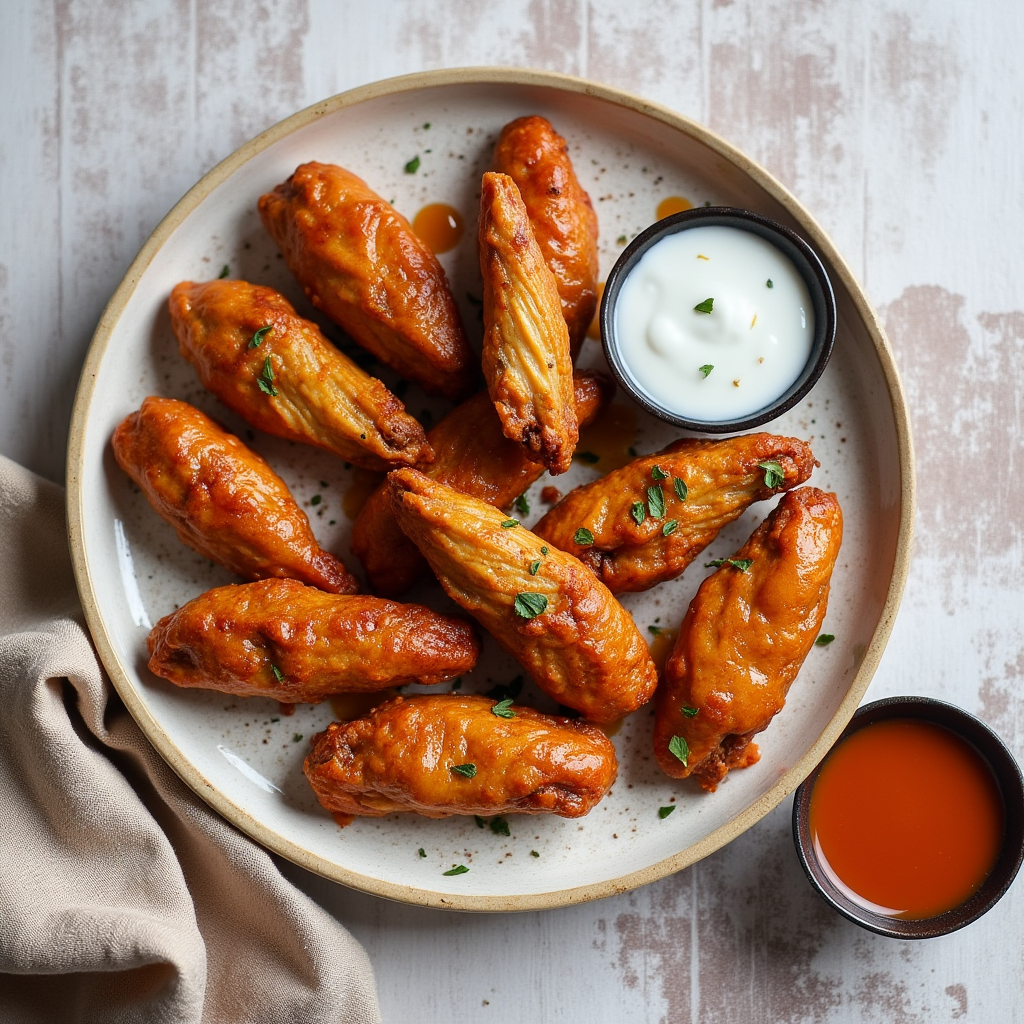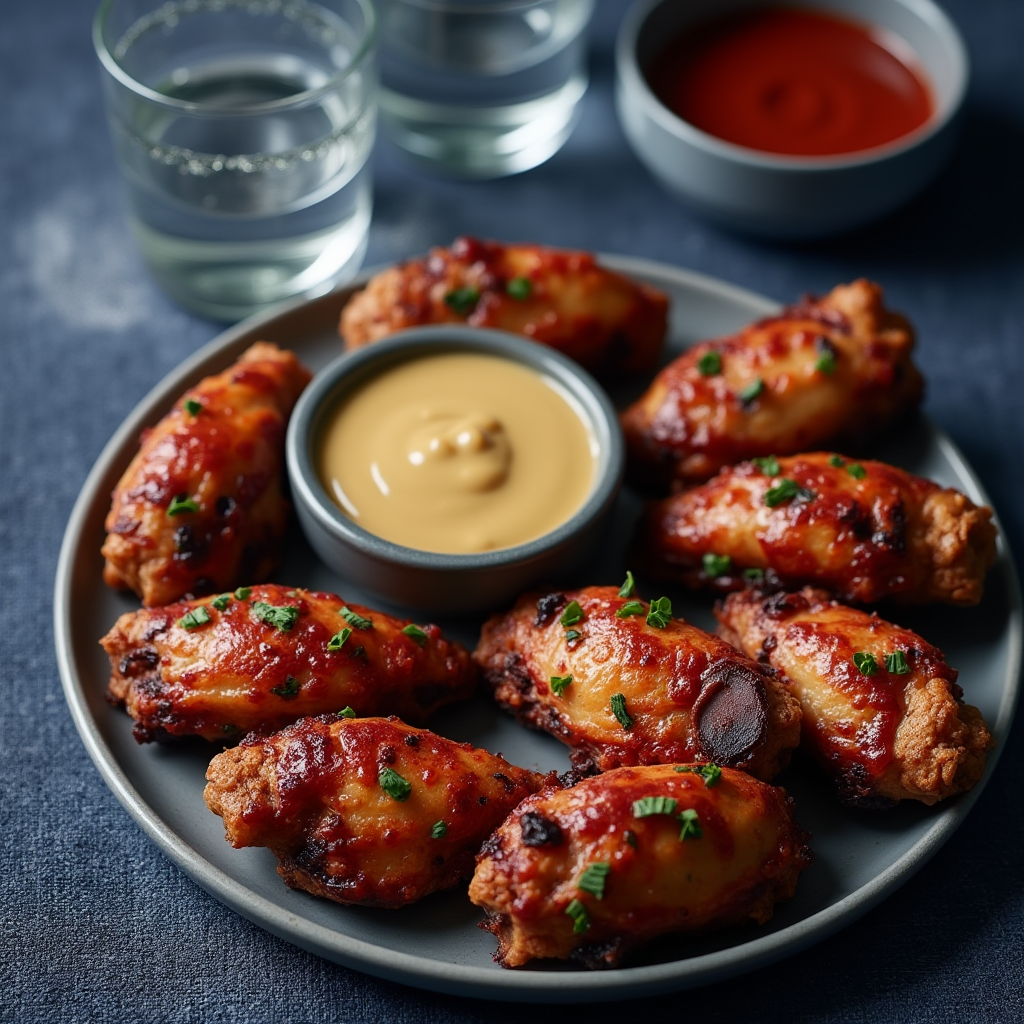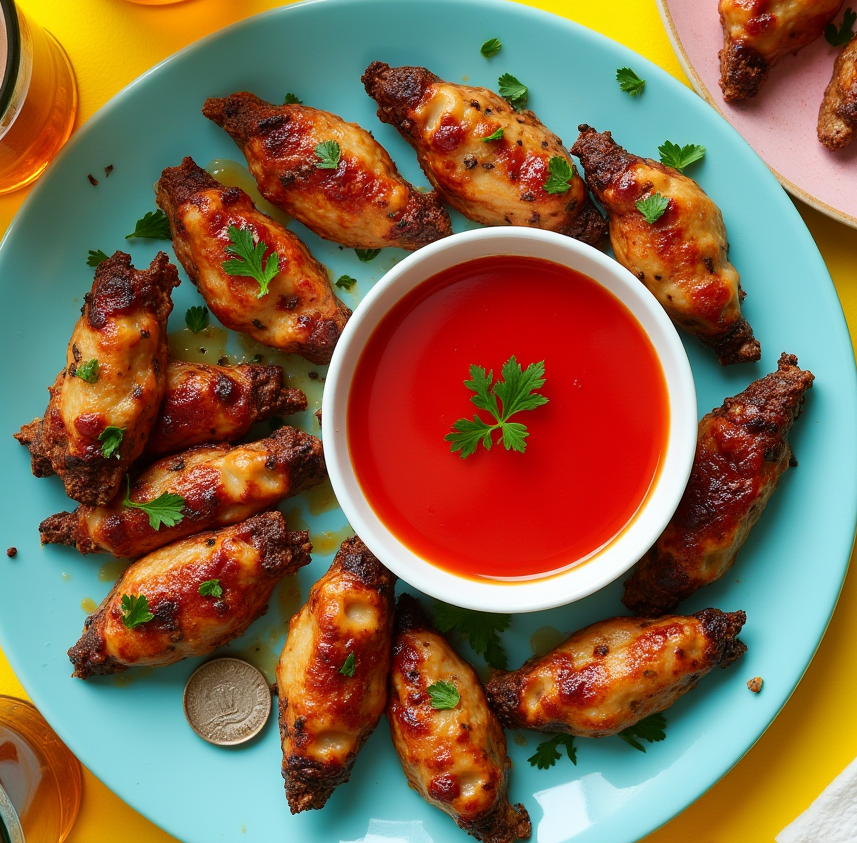When it comes to planning the perfect menu, few dishes captivate as much as chicken wings. Their versatility makes them suitable for any occasion, whether it’s a casual game night, a festive holiday spread, or a backyard BBQ. Popular recipes range from classic buffalo wings with their tangy kick to Asian-inspired variations like honey-soy glazed wings.
Here are some standout recipes to try:
- Buffalo Wings: Tossed in hot sauce and butter, perfect with blue cheese dressing.
- Garlic Parmesan Wings: A savory option that pairs well with crispy fries.
- Honey Mustard Wings: Sweet and tangy, ideal for family-friendly gatherings.
- Teriyaki Wings: A Japanese-inspired treat with a glossy finish.
- Smoked Wings: Achieved through slow cooking for a deep, smoky flavor.
Each recipe can be tailored to personal preferences by adjusting heat levels, sweetness, or spices. The possibilities are endless, making chicken wings a must-have dish in your culinary repertoire.
Why Chicken Wings Are a Culinary Favorite

Chicken wings have long been a beloved dish for food enthusiasts worldwide. Their appeal lies in their ability to absorb flavors, whether it’s through marinades, dry rubs, or dipping sauces. Additionally, they strike the perfect balance between crispy skin and tender meat.
Another reason for their popularity is the simplicity of preparation. Whether you’re frying, baking, or grilling, chicken wings adapt seamlessly to various cooking methods. Beyond their taste, they also bring people together. Sharing a platter of wings fosters a sense of community, whether you’re hosting a party or dining at your favorite restaurant.
Nutritionally, chicken wings can be adjusted to fit different dietary needs. Opt for baked or air-fried versions for a lighter take or go bold with deep-fried wings. Their adaptability ensures they remain a crowd-pleaser, no matter the setting.
Different Types of Chicken Wings Explained
Understanding the types of chicken wings is essential for both cooking and enjoying this iconic dish. Generally, there are three primary segments of the wing:
- Drumettes: These resemble small drumsticks, offering a meatier bite and a slightly firmer texture.
- Flats (or Wingettes): Known for their balanced meat-to-skin ratio, they’re prized for their crispy skin.
- Tips: Often discarded but can be used to make flavorful stock or broth.
Within these categories, cooking methods further differentiate wings. For example, fried wings deliver a crispy exterior, while grilled wings boast a smoky flavor. Some prefer breaded wings for added crunch, while others lean towards naked wings for a lighter option.
Experimenting with various cuts and preparations will help you discover your favorite style. Each type offers unique textures and flavors, making chicken wings a diverse and exciting dish.
The Science Behind Perfectly Crispy Chicken Wings
Achieving the perfect crunch on chicken wings involves a combination of technique and understanding the science behind it. The key lies in moisture control and temperature.
First, patting the wings dry before cooking removes excess water, allowing the skin to crisp rather than steam. If you’re breading the wings, a light coating of flour or cornstarch can help by absorbing additional moisture.
Temperature also plays a pivotal role. For frying, maintaining the oil at 350-375°F ensures that the skin crisps evenly while the meat remains juicy. When baking, preheating the oven and using a wire rack helps circulate hot air around the wings, creating a similar effect.
Another trick is the double-cooking method. Parboiling or pre-baking the wings before frying or grilling renders out fat, resulting in a crunchier finish. Mastering these techniques guarantees perfectly crispy chicken wings every time.
Essential Tools and Equipment for Cooking Chicken Wings
Preparing chicken wings to perfection requires a few essential tools. Having the right equipment ensures consistent results, whether you’re a seasoned chef or a beginner.
Here’s a checklist of must-have items:
- Sharp Knife: For trimming and separating wings into drumettes and flats.
- Wire Rack: Ideal for baking wings evenly without soggy bottoms.
- Thermometer: Ensures oil is at the right temperature or that baked wings reach 165°F internally.
- Mixing Bowls: For tossing wings in marinades or sauces.
- Tongs: A safer way to handle wings during cooking or flipping.
- Air Fryer: A health-conscious option for crispy wings without excess oil.
Optional but helpful tools include a deep fryer for restaurant-quality results and a smoker for adding rich, smoky flavors. With these tools in hand, you’re well-equipped to tackle any chicken wings recipe.
Step-by-Step Guide to Preparing Chicken Wings

Creating mouthwatering chicken wings begins with proper preparation. Here’s a step-by-step guide to ensure your wings are a hit:
- Select Fresh Wings: Look for plump, pink wings without discoloration.
- Trim and Separate: Use a sharp knife to divide wings into drumettes and flats.
- Pat Dry: Remove excess moisture with paper towels.
- Season Generously: Use your choice of spices, marinades, or dry rubs.
- Choose Your Cooking Method: Fry, bake, or grill depending on your preference.
- Monitor Cooking Time: Ensure wings reach an internal temperature of 165°F.
- Toss in Sauce: Coat wings evenly in your desired sauce immediately after cooking.
By following these steps, you’ll consistently produce chicken wings that are flavorful, juicy, and satisfying.
Marinades That Transform Your Chicken Wings
Marinades are a fantastic way to infuse chicken wings with bold flavors. A well-crafted marinade penetrates the meat, ensuring every bite is bursting with taste.
Here are some popular marinade ideas:
- Spicy Sriracha Lime: A fiery blend with a citrusy twist.
- Garlic Herb: A classic combination of garlic, parsley, and olive oil.
- Sweet and Spicy Honey Chili: Balances sweetness and heat beautifully.
- Lemon Pepper: A zesty option that pairs well with baked wings.
- Soy Ginger: A savory, umami-packed marinade with Asian flair.
To maximize flavor, marinate the wings for at least two hours, preferably overnight. Always refrigerate wings while marinating to maintain freshness. The right marinade can take your chicken wings to the next level.
The Role of Dry Rubs in Flavoring Chicken Wings
For those who prefer bold, concentrated flavors, dry rubs are the perfect solution. Unlike marinades, dry rubs don’t require additional time for soaking, making them a quicker option.
Common dry rub ingredients include:
- Paprika
- Garlic Powder
- Onion Powder
- Chili Powder
- Brown Sugar
- Salt and Pepper
To apply, generously coat the wings in the rub, ensuring even coverage. For optimal results, let the seasoned wings rest for 15-30 minutes before cooking. Dry rubs create a crispy exterior packed with flavor, particularly when baked or grilled. Whether you’re a fan of smoky, sweet, or spicy profiles, dry rubs make chicken wings an irresistible dish
Classic Chicken Wing Recipes to Try
Classic chicken wings hold a timeless appeal that satisfies cravings with their bold flavors and simple preparation. These recipes have stood the test of time and remain crowd favorites:
- Buffalo Wings: Tossed in a zesty hot sauce-butter mixture, these wings are a game-day essential.
- Barbecue Wings: Slathered in smoky BBQ sauce, they’re perfect for backyard cookouts.
- Garlic Parmesan Wings: Coated with butter, garlic, and Parmesan cheese, they’re both indulgent and irresistible.
- Honey Mustard Wings: A delightful mix of sweet honey and tangy mustard that’s always a hit with kids and adults alike.
- Lemon Pepper Wings: Lightly seasoned with lemon zest and cracked pepper for a refreshing twist.
These recipes are easy to customize, letting you adjust spice levels or sweetness to match your preferences. Whether baked, fried, or grilled, classic chicken wings bring comfort and satisfaction to any table.
Creative and Unique Chicken Wing Flavors
If you’re looking to step outside the box, creative chicken wing flavors can excite your taste buds and impress guests. Here are some unique ideas:
- Mango Habanero: Combines tropical sweetness with fiery heat.
- Korean Gochujang Wings: A spicy and savory option with rich umami notes.
- Thai Peanut Sauce Wings: A nutty, creamy alternative with a hint of spice.
- Maple Bacon Wings: Sweet maple syrup and crispy bacon bits for indulgence.
- Tandoori Wings: Marinated in yogurt and Indian spices, these wings offer a bold, aromatic flavor.
Experimenting with global ingredients and sauces allows you to create one-of-a-kind wings that stand out. These inventive options prove that chicken wings are more than just a classic comfort food—they’re a canvas for culinary creativity.
Healthier Chicken Wing Options for Guilt-Free Indulgence
Enjoying chicken wings doesn’t have to derail your healthy eating goals. With the right techniques and ingredients, you can create lighter versions without sacrificing flavor.
Here are some tips for healthier chicken wings:
- Bake Instead of Fry: Use a wire rack to achieve crispiness in the oven.
- Air Fryer Method: A low-oil alternative that still delivers a crispy finish.
- Skinless Wings: Opt for skinless cuts to reduce fat content.
- Marinate Wisely: Use low-sodium soy sauce, lemon juice, or Greek yogurt as bases.
- Dry Rub Over Sauce: Skip sugar-laden sauces in favor of flavorful spice blends.
Pair healthier wings with fresh veggie sticks and light dipping sauces like yogurt-based ranch for a balanced treat. Guilt-free indulgence is possible with these nutritious chicken wing options.
Pairing Chicken Wings with Sides and Beverages

The right sides and beverages can elevate your chicken wing experience to a complete feast. Popular sides that complement wings include:
- Celery and Carrot Sticks: A crunchy, refreshing accompaniment.
- Potato Wedges: Seasoned and roasted for a satisfying carb boost.
- Coleslaw: Adds a tangy, creamy contrast to the wings’ bold flavors.
- Cornbread: A sweet, crumbly side that balances spicy wings.
For beverages, pair wings with drinks that match their intensity. Spicy wings go well with cooling options like lager beer or iced tea, while sweet flavors pair beautifully with fruity cocktails or sodas. By thoughtfully pairing sides and drinks, you can create a dining experience as unforgettable as the wings themselves.
Common Mistakes to Avoid When Making Chicken Wings
Even seasoned cooks can encounter challenges when preparing chicken wings. Avoid these common pitfalls to ensure your wings turn out perfectly every time:
- Skipping the Drying Step: Excess moisture prevents crispy skin. Pat wings dry before seasoning or cooking.
- Overcrowding the Pan: Crowding reduces heat circulation, leading to uneven cooking. Use a single layer with space between each wing.
- Undercooking: Always use a meat thermometer to ensure wings reach 165°F internally.
- Ignoring the Sauce Timing: Toss wings in sauce immediately after cooking for maximum absorption.
- Using the Wrong Temperature: Maintain consistent heat for frying or baking to achieve the desired crispiness.
Avoiding these mistakes will help you prepare flawless chicken wings that are crispy, flavorful, and perfectly cooked.
How to Serve Chicken Wings Like a Pro
Presentation plays a crucial role in making chicken wings a standout dish. Here are some tips for serving wings like a professional:
- Use Platters: Arrange wings neatly on a large serving platter for visual appeal.
- Offer Variety: Include multiple flavors to cater to different preferences.
- Provide Dipping Sauces: Serve ranch, blue cheese, or spicy mayo in small bowls.
- Add Garnishes: Sprinkle chopped parsley, sesame seeds, or grated Parmesan for an elegant touch.
- Include Sides: Pair wings with celery sticks, fries, or coleslaw for a complete spread.
By focusing on presentation and variety, you can elevate chicken wings from a casual snack to a memorable centerpiece.
FAQs About Chicken Wings: Everything You Need to Know
What are the benefits of oven-baked chicken wings?
Oven-baked chicken wings offer a healthier alternative to fried versions, as they require little to no oil while still delivering delicious flavor. Additionally, baking reduces mess and minimizes grease splatter, making cleanup easier. By using a wire rack, you can achieve crispiness comparable to frying without the extra calories. Moreover, baked wings are versatile—you can season them with dry rubs or sauces to match any preference.
What sauce pairs best with chicken wings?
The best sauce for chicken wings depends on your flavor preferences, but classic options include tangy buffalo sauce for a spicy kick or rich barbecue sauce for a smoky touch. Alternatively, ranch or blue cheese dipping sauces provide a creamy contrast to bold flavors. For something different, try honey mustard for sweetness or garlic parmesan for a savory twist. In every case, the right sauce enhances the flavor and complements the texture of the wings.
What are chicken wings?
Chicken wings are a popular dish made from the wings of a chicken, typically divided into drumettes and flats for easy preparation and eating. They are celebrated for their crispy skin and tender meat, which can absorb a variety of flavors. Traditionally fried, baked, or grilled, they’re often coated in sauces or dry rubs to create diverse flavor profiles. Widely loved as a snack, appetizer, or main course, chicken wings are perfect for any occasion.
Conclusion
Chicken wings are a culinary treasure that transcends occasions and preferences. From classic recipes to unique flavor combinations, they offer endless possibilities for experimentation. With the right techniques, tools, and pairings, anyone can master the art of preparing wings. By avoiding common mistakes and embracing creative ideas, you’ll transform a simple dish into a memorable experience. Whether hosting a party or enjoying a quiet night in, chicken wings are sure to be the star of the table.

